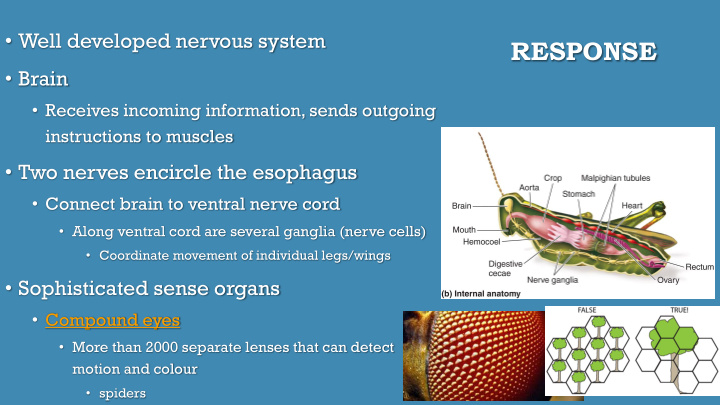



• Well developed nervous system RESPONSE • Brain • Receives incoming information, sends outgoing instructions to muscles • Two nerves encircle the esophagus • Connect brain to ventral nerve cord • Along ventral cord are several ganglia (nerve cells) • Coordinate movement of individual legs/wings • Sophisticated sense organs • Compound eyes • More than 2000 separate lenses that can detect motion and colour • spiders
• Well developed muscle groups MOVEMENT • Controlled and coordinated by nervous system • Some • Muscles made up of individual muscle cells • Contract to become shorter when stimulated by nerves • Others • Muscles generate force by contracting and pulling on the exoskeleton • At each joint different muscles flex/extend the joint • Pull of the muscles against the exoskeleton allows arthropods to beat their wings against the air, push legs against ground to walk or use flippers to swim
• Terrestrial REPRODUCTION • Internal fertilization • Male places sperm in female or; • Male deposits a sperm packet that is picked up • Aquatic • Internal or external fertilization • Spider • Praying Mantis
GROWTH AND DEVELOPMENT • Exoskeleton does not grow as animal grows • Undergo process of molting • Entire exoskeleton is shed • A new one is produced • Controlled by endocrine system • Regulates body processes by means of chemicals called hormones
• As time to molt approaches MOLTING • Skin glands start to digest inner exoskeleton • Other glands secrete a new exoskeleton • When new exoskeleton is ready • Animal pulls itself out of the old one • Process takes several hours • While exoskeleton is still soft • Animal fills with air or fluids to allow room for growth before next molting • The animal is vulnerable to predators • Will complete at night or hide • Most molt several times between hatching and adulthood
• First appeared in the sea 600 mya ARTHROPODS • Evolved into all habitats • Arthropods are classified based on the number and structure of their body segments and appendages — particularly their mouthparts. • The three major groups of arthropods are: • Crustaceans • Spiders and their relatives • Insects and their relatives
Recommend
More recommend